 With a high-end feature set offering auto, scene, aperture and shutter priority modes plus full manual exposure controls, Panasonic’s beautifully sculpted 8 megapixel LX1 is clearly aimed at the discerning photographer who knows their ISO from their f-stop.
With a high-end feature set offering auto, scene, aperture and shutter priority modes plus full manual exposure controls, Panasonic’s beautifully sculpted 8 megapixel LX1 is clearly aimed at the discerning photographer who knows their ISO from their f-stop.
The camera – available in silver or black – is the world’s first compact camera to offer a panoramic 16:9 ratio CCD sensor -perfect for displaying on widescreen TVs – as well as 4:3 and 3:2 shooting ratios.
Despite its traditional appearance, the LX1 provides a class-leading level of control for digital photographers who like to wear the trousers when it comes to exposure (if you, err, get what we mean).
 On most compact digcams, exposure adjustments are invariably achieved by fiddly excursions through endless sub-menus, but the LX1’s design affords fast, direct access to a host of vital functions like ISO rating, shutter speed, aperture and file size/quality – essential for those looking to capture the ‘decisive moment’.
On most compact digcams, exposure adjustments are invariably achieved by fiddly excursions through endless sub-menus, but the LX1’s design affords fast, direct access to a host of vital functions like ISO rating, shutter speed, aperture and file size/quality – essential for those looking to capture the ‘decisive moment’.
Aspect ratios
Most digicams use sensors with a 4:3 aspect ratio (similar to a standard TV), but the LX1 lets you choose between three different picture shapes; 16:9, 3:2 (print size) and 4:3.
 Although some cameras mimic a 16:9 shooting ratio by cropping off the top and bottom of the picture, the LX1 has a true 16:9 sensor, with users able to switch formats via a handy switch on the lens barrel (no sub-menu burrowing needed).
Although some cameras mimic a 16:9 shooting ratio by cropping off the top and bottom of the picture, the LX1 has a true 16:9 sensor, with users able to switch formats via a handy switch on the lens barrel (no sub-menu burrowing needed).
We grew to love the vast, cinema-like sweep of pictures recorded in 16:9 – so much so that photos taken on other digicams looked positively cramped in comparison.
Images came out pin-sharp courtesy of the Leica branded 28-112mm (equiv.), offering a bright F2.8 at the wideangle setting, dropping down to a less impressive F4.9 at the telephoto end.
It’s worth noting that you lose the extreme wideangle when you switch to the more conventional 4:3 or 3:2 modes, which offer a 34-136mm zoom range.
At the back of the camera, there’s a large, bright 207,000 pixel, 2.5-inch LCD screen with a near lag-free refresh rate. We had no problems seeing what was going on in all but the brightest of sunlight, but an optical viewfinder would have been a handy addition.
 Camera controls
Camera controls
The main controls to the right of the LCD were simple and easy to use, and we had no problems navigating the menus using the four-way controller.
A smaller multi-directional ‘joystick’ lets you adjust aperture and shutter speeds in the relevant modes, as well as set manual focus.
Pressing the joystick brings up a convenient ‘quick menu’ for changing common shooting options like ISO, white balance etc – a great example of the photographer-led usability that sets this camera apart from the pack.
Panasonic did blot their copybook slightly however, with a few poor translations in their sub-menus – not what you expect from a top of the range camera.
 Photographic modes
Photographic modes
Along with the enthusiast-pleasing manual, aperture and shutter priority exposure modes, there’s a host of auto scene modes covering just about every photographic eventuality we can think of. These include portrait, sports, food, scenery, night scenery, self-portrait, night portrait and a rather curious ‘baby’ option.
In use, we found the LX1 to be very responsive, with impressively fast focusing, shutter lag and shot-to-shot times.
Exposure was spot on more or less every time, with the camera delivering stunning resolution, razor-sharp images stuffed full of detail.
The control layout proved intuitive and a pleasure to use, and we’d go as far as to say that this is the best handling compact digital camera we’ve ever come across – not only does the LX1 look great, it feels great to use too!
In fact, we found ourselves taking more pictures with the LX1 than any other camera on the desk, with its extensive range of features encouraging creativity and experimentation.
Flawed gem
The Lumix was on track to being our perfect camera, until we found a veritable swarm of bluebottles appearing in the ointment when the sun went down.
We’re talking high ISO image noise. Tons of it.
Even at 80 and 100 ISO there’s more noise than many of its rivals, and as the ISO ratings rose, the heartache increased.
At 200 ISO, you’ll be reaching for noise reduction software like Noise Ninja and Neat Image. At 400 ISO you’ll be wondering what possessed you to spend so much on the camera.
 Of course, the capable image stabilisation goes some way to compensate for these serious shortcomings, allowing handheld longer exposures at low ISO ratings, but that’s going to be a dead loss if you’re trying to freeze action in low light.
Of course, the capable image stabilisation goes some way to compensate for these serious shortcomings, allowing handheld longer exposures at low ISO ratings, but that’s going to be a dead loss if you’re trying to freeze action in low light.
It’s a real shame that Panasonic has kitted this marvellous camera out with such a noisy sensor, although it needn’t be a deal breaker.
If you’re only looking to knock out small prints, then the high ISO noise won’t be so much of an issue, and if you’re prepared to put the work into processing RAW files, things improve radically.
Obviously, if your interest lies in landscapes, cityscapes, studio shots and other scenarios where low ISO ratings and tripods are de facto, image noise becomes a non issue.
 Conclusion
Conclusion
The Lumix LX1 is in many ways the perfect digital compact, offering a feast of features for demanding prosumers with enough automated modes to please the point’n’shoot brigade.
Offering unparalleled handling, lovely Leica-like looks (try saying that after a few beers), superb optics, fast handling and RAW capability, the camera is capable of producing astonishingly good results.
The only thing stopping us awarding the LX1 a frothing-at-the-mouth ten out of ten rating is its poor high ISO handling – but if you’re prepared to work within the camera’s limitations, you can expect to be rewarded with a camera capable of the very, very highest results.
RATING: 86%
Pros: Beautiful finish, fantastic handling, manual controls, pin-sharp lens, image stabilisation.
Cons: Unacceptable noise over 100ISO, clip on lens cover, average battery life.
Lumic LX1
Street price: UK: £350 (~$616 ~e509)
SPECS:
Sensor: 1/1.65″ CCD, 8.61 megapixels (16:9 aspect ratio)
Image Quality: RAW/TIFF/Fine/Standard
Movie clips: Quicktime (.mov) M-JPEG with audio – 640 x 480 (10/30 fps, 320 x 240 (10/30 fps), 848 x 480 (10/30 fps) (16:9)
Lens: Leica DC Vario-Elmarit, 28 – 112 mm equiv. (4x zoom), F2.8 – F4.9
MEGA OIS: (Mode 1 / Mode 2)
Shooting modes: Auto, Program Mode (with Program Shift), Aperture Priority Mode, Shutter Priority Mode, Manual Mode, Portrait, Sports, Food, Scenery, Night Scenery, Self-portrait, Night Portrait, Fireworks, Party, Snow, Baby, Soft Skin, Starry Sky, Candle, Moving Image
Shutter Speeds: 1/4 – 1/2000 sec.: Auto, 60 – 1/2000 sec. Manual
Sensitivity: Auto, ISO 80,100,200,400
Metering: Intelligent Multiple, Center-weighted, Spot
Continuous: 3 fps high speed, 2 fps low speed, 9 frames (standard), 5 frames (fine)
Flash: Auto, on/off, red-eye reduction: on/off, slow sync with red eye reduction
Range (ISO auto): W 0.6m – 4.1m, T: 0.3m – 2.3m
Storage: SD/MMC
Weight (inc batt) 220 g (7.8 oz)
Dimensions 106 x 56 x 26 mm (4.2 x 2.2 x 1.0 in)
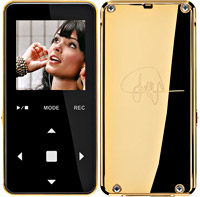 For emotionally insecure types needing the reassuring sparkle of ostentatious bling around their neck, the new gold-plated deluxe MP3 player from Jens of Sweden should be a Godsend.
For emotionally insecure types needing the reassuring sparkle of ostentatious bling around their neck, the new gold-plated deluxe MP3 player from Jens of Sweden should be a Godsend. The player can also display pictures and text documents transferred over its USB port.
The player can also display pictures and text documents transferred over its USB port.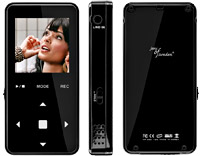 Perhaps mindful of the torrent of complaints that met Apple’s super scratchy Nano player, Nylander added, “The display is sharp and the player is both smaller and more resistant to scratches or blows than hard disk-based players.”
Perhaps mindful of the torrent of complaints that met Apple’s super scratchy Nano player, Nylander added, “The display is sharp and the player is both smaller and more resistant to scratches or blows than hard disk-based players.”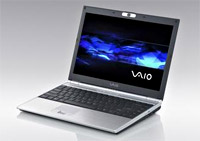 Sony has announced the Japanese release of two new laptops featuring the Intel Duo Core processor.
Sony has announced the Japanese release of two new laptops featuring the Intel Duo Core processor. The new super-skinny SZ series (0.9″ wide) comes with either a 945GM Express or the GeForce Go 7400 graphics card which offers an unusual SPEED/STAMINA switch.
The new super-skinny SZ series (0.9″ wide) comes with either a 945GM Express or the GeForce Go 7400 graphics card which offers an unusual SPEED/STAMINA switch.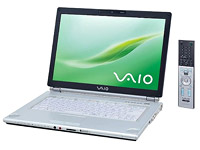 Sony F TV Series
Sony F TV Series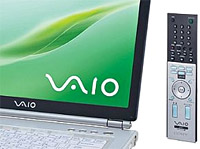 According to Sony Japan’s website, the laptops will be available in a range of configurations and made available in Japan over the next few weeks.
According to Sony Japan’s website, the laptops will be available in a range of configurations and made available in Japan over the next few weeks.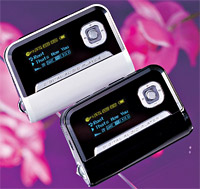 MobiBlu’s soon-to-be-released DAH-1900 MP3 Player (256mb/512mb/1gb) claims to have the longest battery life of any MP3 player in the entire known universe.
MobiBlu’s soon-to-be-released DAH-1900 MP3 Player (256mb/512mb/1gb) claims to have the longest battery life of any MP3 player in the entire known universe.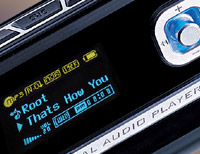 The display can be used to stream song lyrics for pub-like solo singalongs, courtesy of an editable Auto Lyric system.
The display can be used to stream song lyrics for pub-like solo singalongs, courtesy of an editable Auto Lyric system. For nippy transfer of files from a PC, the DAH-1900 offers a High-Speed USB 2.0 interface at up to 40 Mbps transmission speed.
For nippy transfer of files from a PC, the DAH-1900 offers a High-Speed USB 2.0 interface at up to 40 Mbps transmission speed.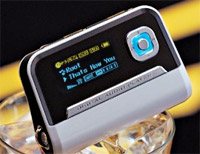 Available colours
Available colours Panasonic has unveiled its new ultra-zoom prosumer digital camera, the Panasonic Lumix DMC-FZ7.
Panasonic has unveiled its new ultra-zoom prosumer digital camera, the Panasonic Lumix DMC-FZ7.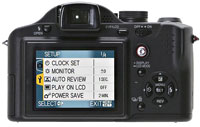 Inherited from Panasonic’s high end Lumix LX1 compact is a new ‘joystick’ control affording fast, easy access to settings such as ISO, image size & quality and white balance.
Inherited from Panasonic’s high end Lumix LX1 compact is a new ‘joystick’ control affording fast, easy access to settings such as ISO, image size & quality and white balance. Like the LX1, the camera also offers a vast array of exposure options, including Program, Aperture Priority, Shutter Priority and fully manual, backed up by an exhaustive set of ‘scene’ options covering the useful (‘sports’) to the bizarre (‘soft skin’).
Like the LX1, the camera also offers a vast array of exposure options, including Program, Aperture Priority, Shutter Priority and fully manual, backed up by an exhaustive set of ‘scene’ options covering the useful (‘sports’) to the bizarre (‘soft skin’).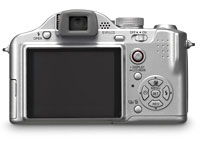 Specifications:
Specifications: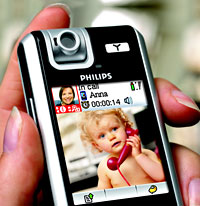 It’s been a long time coming, but Dutch enormo-corp Philips are looking set to finally roll out their innovative Wi-Fi-enabled VoIP telephone, the VP-5500.
It’s been a long time coming, but Dutch enormo-corp Philips are looking set to finally roll out their innovative Wi-Fi-enabled VoIP telephone, the VP-5500.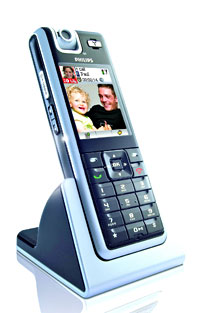 Announced way back in Sept 2005, the VoIP phone comes with a VGA camera that rotates up to 240 degrees, letting users check out their look on the built-in, high-resolution LCD display before committing a potential videocall fashion catastrophe.
Announced way back in Sept 2005, the VoIP phone comes with a VGA camera that rotates up to 240 degrees, letting users check out their look on the built-in, high-resolution LCD display before committing a potential videocall fashion catastrophe. Built around established standards-based technologies like Wi-Fi and Linux, the VP5500 can be upgraded wirelessly, opening the door to future upgrades – giving operators the chance to add value-added services as the becmoe available.
Built around established standards-based technologies like Wi-Fi and Linux, the VP5500 can be upgraded wirelessly, opening the door to future upgrades – giving operators the chance to add value-added services as the becmoe available. To be honest, we’re still a little unsure about video calling.
To be honest, we’re still a little unsure about video calling.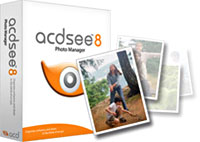 A heady mix of ever plummeting digicam prices, larger memory card capacities and more capacious hard drives means that it’s easy to end up with photos and videos scattered to the four corners of your PC, making it nigh on impossible to find your pictures.
A heady mix of ever plummeting digicam prices, larger memory card capacities and more capacious hard drives means that it’s easy to end up with photos and videos scattered to the four corners of your PC, making it nigh on impossible to find your pictures. A start-up screen gives new users an overview of features to help them get started while upgraders will be glad to see the program sticking to the tried and trusted three-paned interface, coupled with a useful ‘image basket’ function.
A start-up screen gives new users an overview of features to help them get started while upgraders will be glad to see the program sticking to the tried and trusted three-paned interface, coupled with a useful ‘image basket’ function. Unlike many other image management programs, you don’t have to ‘import’ images into the program before they can be viewed, so the program also doubles up as an excellent image file browser.
Unlike many other image management programs, you don’t have to ‘import’ images into the program before they can be viewed, so the program also doubles up as an excellent image file browser. At times, the sheer weight of features can prove a little overwhelming to new users, but for keen photographers keen to keep a vice-like grip on their growing photo collections and looking for a strong, all-round image management solution, we strongly recommend ACDSee.
At times, the sheer weight of features can prove a little overwhelming to new users, but for keen photographers keen to keep a vice-like grip on their growing photo collections and looking for a strong, all-round image management solution, we strongly recommend ACDSee.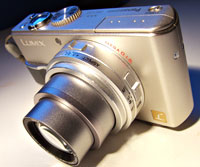 With a high-end feature set offering auto, scene, aperture and shutter priority modes plus full manual exposure controls, Panasonic’s beautifully sculpted 8 megapixel LX1 is clearly aimed at the discerning photographer who knows their ISO from their f-stop.
With a high-end feature set offering auto, scene, aperture and shutter priority modes plus full manual exposure controls, Panasonic’s beautifully sculpted 8 megapixel LX1 is clearly aimed at the discerning photographer who knows their ISO from their f-stop.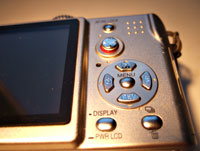 On most compact digcams, exposure adjustments are invariably achieved by fiddly excursions through endless sub-menus, but the LX1’s design affords fast, direct access to a host of vital functions like ISO rating, shutter speed, aperture and file size/quality – essential for those looking to capture the ‘decisive moment’.
On most compact digcams, exposure adjustments are invariably achieved by fiddly excursions through endless sub-menus, but the LX1’s design affords fast, direct access to a host of vital functions like ISO rating, shutter speed, aperture and file size/quality – essential for those looking to capture the ‘decisive moment’.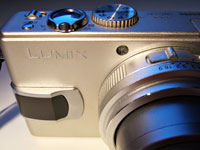 Although some cameras mimic a 16:9 shooting ratio by cropping off the top and bottom of the picture, the LX1 has a true 16:9 sensor, with users able to switch formats via a handy switch on the lens barrel (no sub-menu burrowing needed).
Although some cameras mimic a 16:9 shooting ratio by cropping off the top and bottom of the picture, the LX1 has a true 16:9 sensor, with users able to switch formats via a handy switch on the lens barrel (no sub-menu burrowing needed).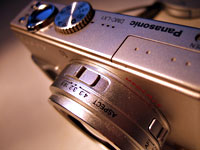 Camera controls
Camera controls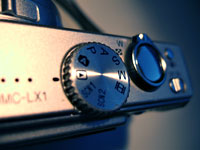 Photographic modes
Photographic modes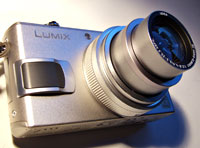 Of course, the capable image stabilisation goes some way to compensate for these serious shortcomings, allowing handheld longer exposures at low ISO ratings, but that’s going to be a dead loss if you’re trying to freeze action in low light.
Of course, the capable image stabilisation goes some way to compensate for these serious shortcomings, allowing handheld longer exposures at low ISO ratings, but that’s going to be a dead loss if you’re trying to freeze action in low light.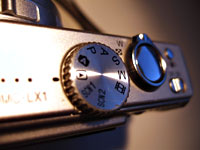 Conclusion
Conclusion Way back in October last year we reported that Samsung was
Way back in October last year we reported that Samsung was  Still, it’s a very capable camera, offering a 6 megapixel sensor, 2.5-inch screen (210K pixels), expansive ISO range from 200 to 3200, a host of shooting modes and a Pentax AF lens mount.
Still, it’s a very capable camera, offering a 6 megapixel sensor, 2.5-inch screen (210K pixels), expansive ISO range from 200 to 3200, a host of shooting modes and a Pentax AF lens mount.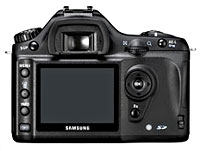 Although some may not see the point in Samsung announcing what amounts to an already released product under a different name, there are clear benefits for both companies.
Although some may not see the point in Samsung announcing what amounts to an already released product under a different name, there are clear benefits for both companies.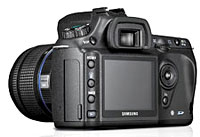 With more units shifted, Pentax benefit from lower production costs, increased sales and a greatly increased user base for their lenses and their system, thus ensuring the future of its system.
With more units shifted, Pentax benefit from lower production costs, increased sales and a greatly increased user base for their lenses and their system, thus ensuring the future of its system.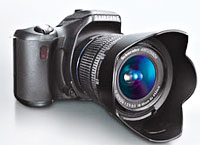 Then there’s the awesome might of Samsung’s marketing budget to consider, with some suspecting that the new camera will be sold as a “loss leader” to help establish the brand.
Then there’s the awesome might of Samsung’s marketing budget to consider, with some suspecting that the new camera will be sold as a “loss leader” to help establish the brand. It might look like a run-of-the-mill Gameboy Advance SP, but the TAVI Portable Media Player packs a much mightier multimedia punch, with the wee fella letting you watch movies, playback music, look at your photos, listen to FM radio, read eBooks and record your own voice.
It might look like a run-of-the-mill Gameboy Advance SP, but the TAVI Portable Media Player packs a much mightier multimedia punch, with the wee fella letting you watch movies, playback music, look at your photos, listen to FM radio, read eBooks and record your own voice. Audio support is pretty generous too, with the unit offering MP3, WMA, OGG, AC3 and AAC playback.
Audio support is pretty generous too, with the unit offering MP3, WMA, OGG, AC3 and AAC playback.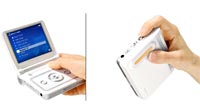 There’s also a built in FM radio and mic, line-in recording (audio only) and TXT reader support.
There’s also a built in FM radio and mic, line-in recording (audio only) and TXT reader support.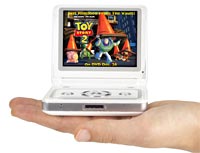 SPECIFICATIONS
SPECIFICATIONS PHOTOS & eBOOKS
PHOTOS & eBOOKS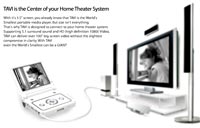 POWER
POWER